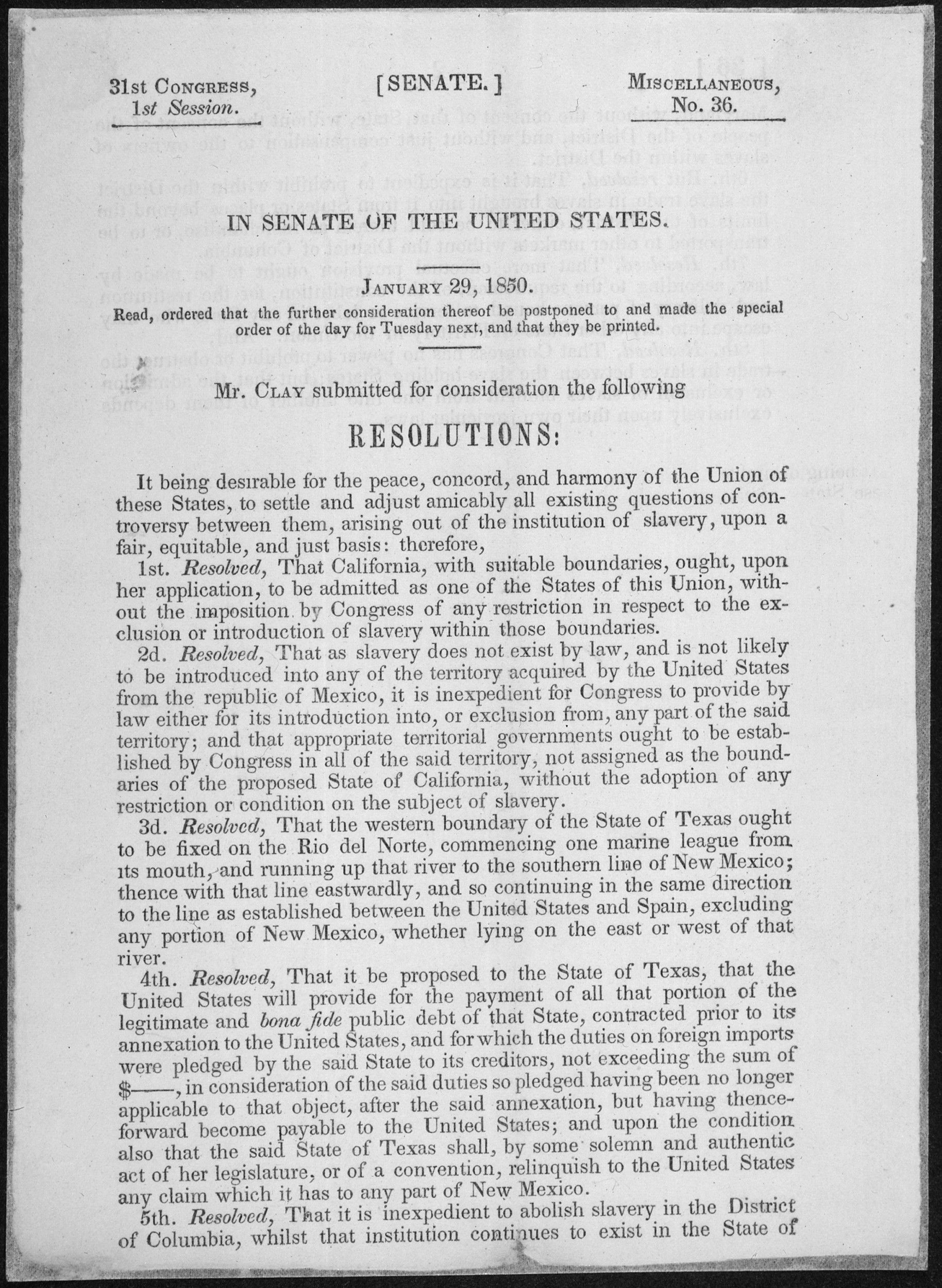The Compromise of 1850
1/29/1850
Add to Favorites:
Add all page(s) of this document to activity:

Add only page 1 to activity:
Add only page 2 to activity:
Add only page 3 to activity:
Add only page 4 to activity:
Add only page 5 to activity:
Add only page 6 to activity:
Add only page 7 to activity:
Senator Henry Clay introduced this resolution, now called the Compromise of 1850, to address issues over slavery. The Compromise was actually a series of bills, mainly related to slavery. They provided for slavery to be decided by popular sovereignty in the admission of new states, prohibited the slave trade in the District of Columbia, settled a Texas boundary dispute, and established a stricter fugitive slave act.
By 1850 sectional disagreements related to slavery were straining the bonds of union between the North and South. These tensions became especially critical when Congress began to consider whether western lands acquired after the Mexican-American War would permit slavery. In 1849, California requested permission to enter the Union as a "free state" – meaning one where slavery was banned. Adding more "free state" senators to Congress would destroy the balance between "slave" and "free" states that had existed since the Missouri Compromise of 1820.
Because everyone looked to the Senate to defuse the growing crisis, Senator Henry Clay of Kentucky proposed a series of resolutions designed to "adjust amicably all existing questions of controversy...arising out of the institution of slavery." Clay attempted to frame his compromise so that nationally minded senators would vote for legislation in the interest of the Union.
In one of the most famous congressional debates in American history, the Senate discussed Clay’s solution for seven months. It initially voted down his legislative package, but Senator Stephen A. Douglas of Illinois stepped forward with substitute bills, which passed both Houses. With the Compromise of 1850, Congress had addressed the immediate crisis created by the recent territorial expansion.
But one aspect of the compromise – a strengthened fugitive slave act – soon began to threaten sectional peace. Though a fugitive slave clause was included in the Constitution and supported by legislation since the founding of the nation, the Fugitive Slave Act of 1850 added several new regulations. For example, both federal and local law enforcement in all states (both "slave" and "free") were required to enforce the legislation and arrest suspected fugitive slaves. In addition, anyone aiding an enslaved person escape from bondage was subject to imprisonment and a fine. The enforcement of these strict requirements angered many in the North.
The Compromise of 1850 is composed of five statutes enacted in September of 1850. The acts called for the admission of California as a "free state," provided for a territorial government for Utah and New Mexico, established a boundary between Texas and the United States, called for the abolition of slave trade in Washington, DC, and amended the Fugitive Slave Act.
By 1850 sectional disagreements related to slavery were straining the bonds of union between the North and South. These tensions became especially critical when Congress began to consider whether western lands acquired after the Mexican-American War would permit slavery. In 1849, California requested permission to enter the Union as a "free state" – meaning one where slavery was banned. Adding more "free state" senators to Congress would destroy the balance between "slave" and "free" states that had existed since the Missouri Compromise of 1820.
Because everyone looked to the Senate to defuse the growing crisis, Senator Henry Clay of Kentucky proposed a series of resolutions designed to "adjust amicably all existing questions of controversy...arising out of the institution of slavery." Clay attempted to frame his compromise so that nationally minded senators would vote for legislation in the interest of the Union.
In one of the most famous congressional debates in American history, the Senate discussed Clay’s solution for seven months. It initially voted down his legislative package, but Senator Stephen A. Douglas of Illinois stepped forward with substitute bills, which passed both Houses. With the Compromise of 1850, Congress had addressed the immediate crisis created by the recent territorial expansion.
But one aspect of the compromise – a strengthened fugitive slave act – soon began to threaten sectional peace. Though a fugitive slave clause was included in the Constitution and supported by legislation since the founding of the nation, the Fugitive Slave Act of 1850 added several new regulations. For example, both federal and local law enforcement in all states (both "slave" and "free") were required to enforce the legislation and arrest suspected fugitive slaves. In addition, anyone aiding an enslaved person escape from bondage was subject to imprisonment and a fine. The enforcement of these strict requirements angered many in the North.
The Compromise of 1850 is composed of five statutes enacted in September of 1850. The acts called for the admission of California as a "free state," provided for a territorial government for Utah and New Mexico, established a boundary between Texas and the United States, called for the abolition of slave trade in Washington, DC, and amended the Fugitive Slave Act.
Transcript
In the Senate of the United StatesJanuary 29, 1850
Read, ordered that the futher consideration therof be postponed to and made the special order of the day for Tuesday next and that they be printed.
Mr. Clay submitted for consideration the following
Resolutions:
It being desirable, for the peace, concord, and harmony of the Union of these States, to settle and adjust amicably all existing questions of controversy between them aris- ing out of the institution of slavery upon a fair, equitable and just basis: therefore,
1. Resolved, That California, with suitable boundaries, ought, upon her application to be admitted as one of the States of this Union, without the imposition by Congress of any restriction in respect to the exclusion or in- troduction of slavery within those bound- aries.
2. Resolved, That as slavery does not exist by law, and is not likely to be introduced into any of the territory acquired by the United States from the republic of Mexico, it is in- expedient for Congress to provide by law either for its introduction into, or exclusion from, any part of the said territory; and that appropriate territorial governments ought to be established by Congress in all of the said territory , not assigned as the boundaries of the proposed State of California, without the adoption of any restriction or condition on the subject of slavery.
3. Resolved, That the western boundary of the State of Texas ought to be fixed on the Rio del Norte, ommencing one marine league from its mouth, and running up that river to the southern line of New Mexico; thence with that line eastwardly, and so continuing in the same direction to the line as established between the United States and Spain, exclud- ing any portion of New Mexico, whether lying on the east or west of that river.
4. Resolved, That it be proposed to the State of Texas, that the United States will provide for the payment of all that portion of the legitimate and bona fide public debt of that State contracted prior to its annexation to the United States, and for which the duties on foreign imports were pledged by the said State to its creditors, not exceeding the sum of- dollars, in consideration of the said duties so pledged having been no longer ap- plicable to that object after the said annexa- tion, but having thenceforward become pay- able to the United States; and upon the condition, also, that the said State of Texas shall, by some solemn and authentic act of her legislature or of a convention, relinquish to the United States any claim which it has to any part of New Mexico.
5. Resolved, That it is inexpedient to abol- ish slavery in the District of Columbia whilst that institution continues to exist in the State of
Maryland, without the consent of that State, without the consent of the people of the District, and without just compensation to the owners of slaves within the District.
6. But, resolved, That it is expedient to prohibit, within the District, the slave trade in slaves brought into it from States or places beyond the limits of the District, either to be sold therein as merchandise, or to be trans- ported to other markets without the District of Columbia.
7. Resolved, That more effectual provision ought to be made by law, according to the
requirement of the constitution, for the restitution and delivery of persons bound to serv- ice or labor in any State, who may escape into any other State or Territory in the Union. And,
8. Resolved, That Congress has no power to promote or obstruct the trade in slaves be- tween the slaveholding States; but that the admission or exclusion of slaves brought from one into another of them, depends exclusively upon their own particular laws.
This primary source comes from the Records of the U.S. Senate.
National Archives Identifier: 306270
Full Citation: Resolution introduced by Senator Henry Clay in relation to the adjustment of all existing questions of controversy between the states arising out of the institution of slavery (the resolution later became known as the Compromise of 1850); 1/29/1850; Senate Simple Resolutions, Motions, and Orders of the 31st Congress; Bills and Resolutions Originating in the Senate, 1789 - 2002; Records of the U.S. Senate, Record Group 46; National Archives Building, Washington, DC. [Online Version, https://www.docsteach.org/documents/document/compromise-1850, April 25, 2024]Activities that use this document
- From Slavery to Juneteenth: Emancipation and Ending Enslavement
Created by the National Archives Education Team - What Else Was Happening During the Civil War Era?
Created by the National Archives Education Team
Rights: Public Domain, Free of Known Copyright Restrictions. Learn more on our privacy and legal page.










